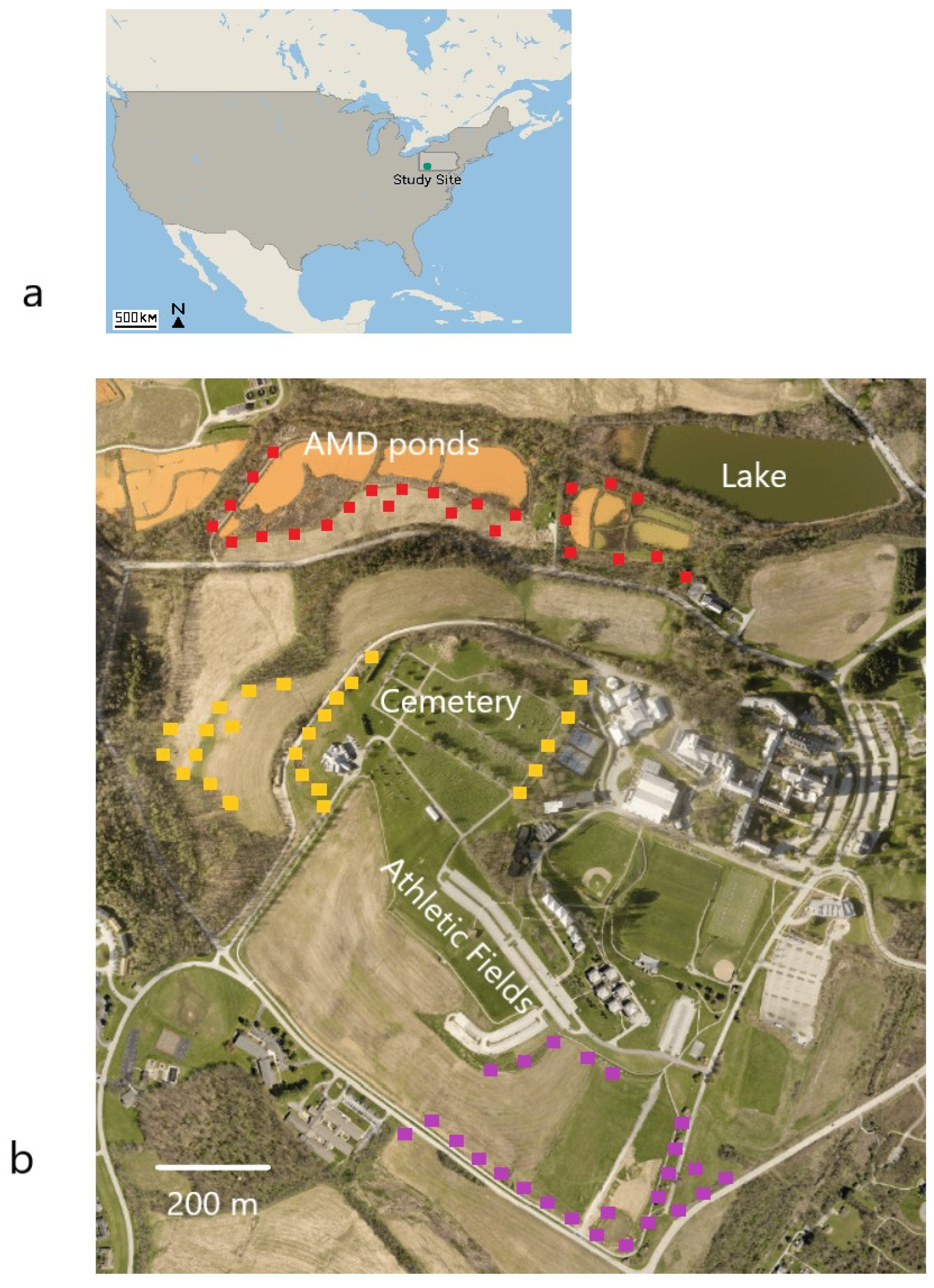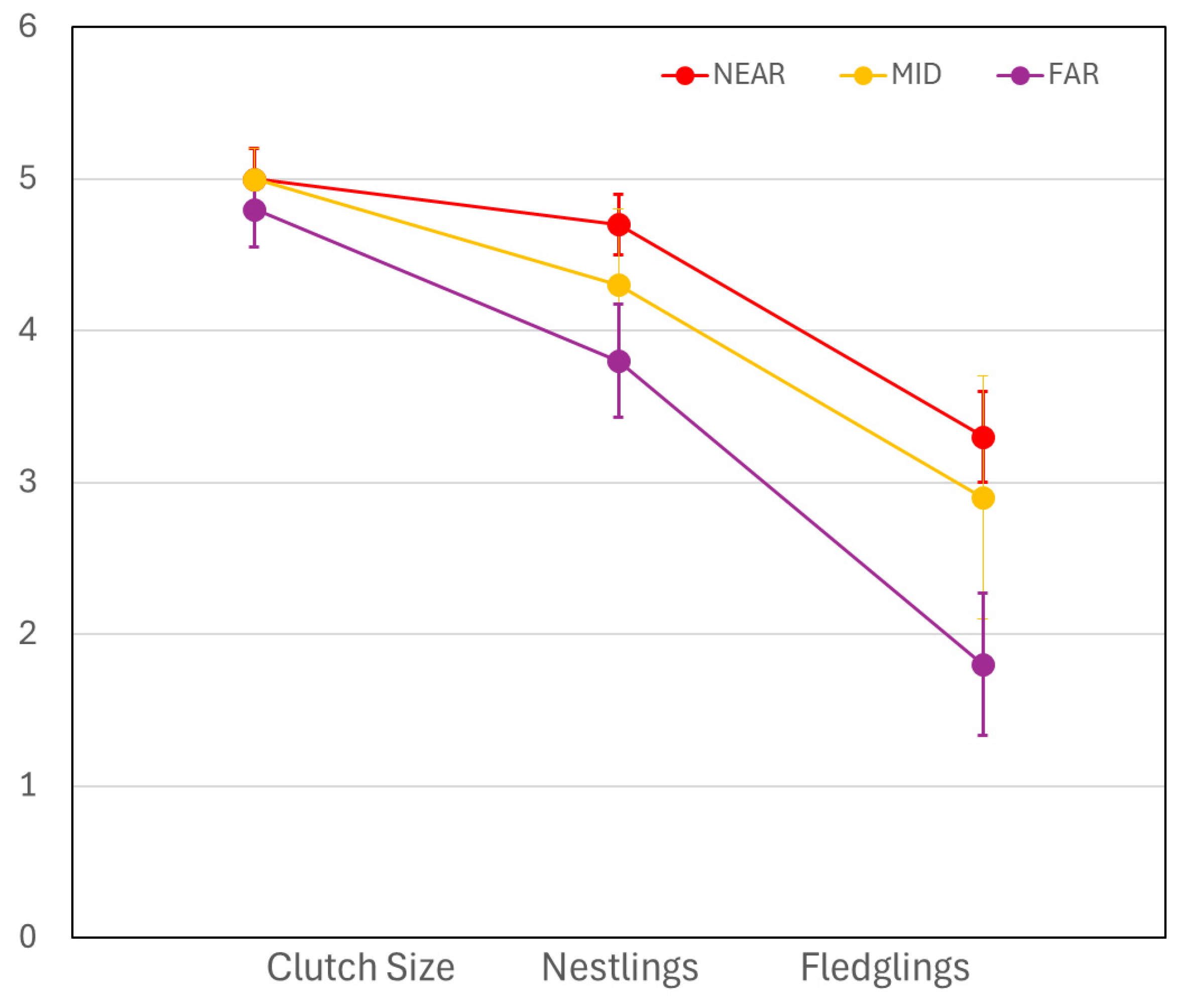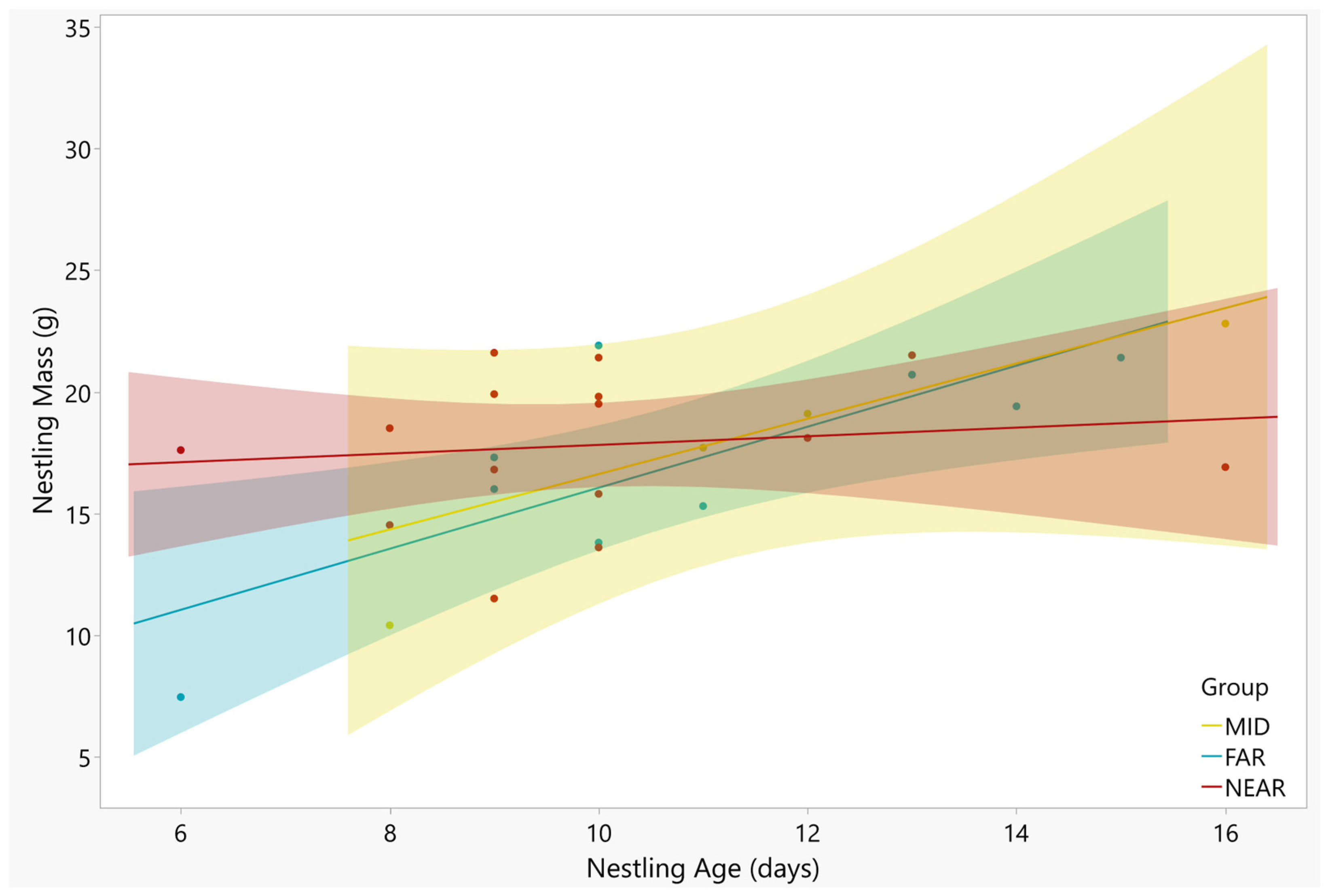Reproductive Success of Tree Swallows at Abandoned Mine Drainage Treatment Ponds
Abstract
Simple Summary
Abstract
1. Introduction
2. Materials and Methods
2.1. Study Site
2.2. Study Species
2.3. Nest Box Setup and Monitoring
2.4. Data Analysis
3. Results
3.1. Nest Parameters
3.2. Morphometrics
4. Discussion
4.1. Values of Reproductive Parameters in Comparison to Other Studies
4.2. Study Limitations and Suggestions for Future Research
Supplementary Materials
Author Contributions
Funding
Institutional Review Board Statement
Data Availability Statement
Acknowledgments
Conflicts of Interest
References
- Bussiere, B. Acid mine drainage from abandoned mine sites: Problematic acid reclamation approaches. In Proceedings of the International Symposium on Geo-Environmental Engineering, Hangzhou, China, 8–10 September 2009; pp. 111–125. [Google Scholar]
- Porter, C.M.; Nairn, R.W. Ecosystem functions within a mine drainage passive treatment system. Ecol. Eng. 2008, 32, 337–346. [Google Scholar] [CrossRef]
- Hogsden, K.L.; Harding, J.S. Consequences of acid mine drainage for the structure and function of benthic stream communities: A review. Freshw. Sci. 2012, 31, 108–120. [Google Scholar] [CrossRef]
- Méndez-García, C.; Peláez, A.I.; Mesa, V.; Sánchez, J.; Golyshina, O.V.; Ferrer, M. Microbial diversity and metabolic networks in acid mine drainage habitats. Front. Microbiol. 2015, 6, 475. [Google Scholar] [CrossRef]
- Skousen, J.; Zipper, C.E.; Rose, A.; Ziemkiewicz, P.F.; Nairn, R.; McDonald, L.M.; Kleinmann, R.L. Review of passive systems for acid mine drainage treatment. Mine Water Environ. 2017, 36, 133–153. [Google Scholar] [CrossRef]
- Monastery Run Improvement Project. Saint Vincent College, Latrobe, Pa. Available online: https://www.stvincent.edu/academics/experiential-learning/community-outreach/monastery-run-improvement-project.html (accessed on 3 March 2024).
- Lidman, J.; Jonsson, M.; Berglund, A.M.M. The effect of lead (Pb) and zinc (Zn) contamination on aquatic insect community composition and metamorphosis. Sci. Tot. Environ. 2020, 734, 139406. [Google Scholar] [CrossRef] [PubMed]
- Batty, L.C.; Atkin, L.; Manning, D.A.C. Assessment of the ecological potential of mine-water treatment wetlands using a baseline survey of macroinvertebrate communities. Environ. Pollut. 2005, 138, 412–419. [Google Scholar] [CrossRef] [PubMed]
- Twining, C.W.; Shipley, J.R.; Winkler, D.W. Aquatic insects rich in omega-3 fatty acids drive breeding success in a widespread bird. Ecol. Letters 2018, 21, 1812–1820. [Google Scholar] [CrossRef] [PubMed]
- Wiseman, I.M.; Rutt, G.P.; Edwards, P.J. Constructed wetlands for minewater treatment: Environmental benefits and ecological recovery. Water Environ. J. 2004, 18, 133–138. [Google Scholar] [CrossRef]
- Lacki, M.J.; Hummer, J.W.; Webster, H.J. Avian diversity patterns at a constructed wetland: Use of ecological theory in the evaluation of a mine land reclamation technique. Int. J. Surf. Min. Reclam. Env. 1991, 5, 101–105. [Google Scholar] [CrossRef]
- Jaques, R.O.; Moorhouse-Parry, A.M.; Carline, R.; Mayes, W.M.; Hull, S.L. Biodiversity benefits of coal mine water remediation schemes for bird life. In Proceedings of the International Mine Water Association Congress “Mine Water Management for Future Generations”; Stanley, P., Wolkersdorfer, C., Wolkersdorfer, K., Eds.; International Mine Water Association: Cardiff, UK, 2021; pp. 206–211. [Google Scholar]
- Sievers, M.; Parris, K.M.; Swearer, S.E.; Hale, R. Stormwater wetlands can function as ecological traps for urban frogs. Ecol. Appl. 2018, 28, 1106–1115. [Google Scholar] [CrossRef]
- Titeux, N.; Aizpurua, O.; Hollander, F.A.; Sardà-Palomera, F.; Hermoso, V.; Paquet, J.-Y.; Mestdagh, X.; Settele, J.; Brotons, L.; Van Dyck, H. Ecological traps and species distribution models: A challenge for prioritizing areas of conservation importance. Ecography 2020, 43, 365–375. [Google Scholar] [CrossRef]
- Zhang, C.; Wen, L.; Wang, Y.; Liu, C.; Zhou, Y.; Lei, G. Can constructed wetlands be wildlife refuges? A review of their potential biodiversity conservation value. Sustainability 2020, 12, 1442. [Google Scholar] [CrossRef]
- Dawson, R.D. Timing of breeding and environmental factors as determinants of reproductive performance of tree swallows. Can. J. Zool. 2008, 86, 843–850. [Google Scholar] [CrossRef]
- Winkler, D.W.; Hallinger, K.K.; Ardia, D.R.; Robertson, R.J.; Stutchbury, B.J.; Cohen, R.R. Tree Swallow (Tachycineta bicolor), version 1.0. In Birds of the World; Poole, A.F., Ed.; Cornell Lab of Ornithology: Ithaca, NY, USA, 2020. [Google Scholar] [CrossRef]
- Tinbergen, J.M.; Boerlijst, M.C. Nestling weight and survival in individual Great Tits (Parus major). J. Anim. Ecol. 1990, 59, 1113–1127. [Google Scholar] [CrossRef]
- Mengelkoch, J.M.; Niemi, G.; Ronald, J.; Regal, R. Diet of the nestling Tree Swallow. Condor 2004, 106, 423–429. [Google Scholar] [CrossRef]
- McCarty, J.P. The number of visits to the nest by parents is an accurate measure of food delivered to nestlings in Tree Swallows. J. Field Ornithol. 2002, 73, 9–14. [Google Scholar] [CrossRef]
- McCarty, J.P.; Winkler, D.W. Foraging ecology and diet selectivity of Tree Swallows feeding nestlings. Condor 1999, 101, 246–254. [Google Scholar] [CrossRef]
- Ardia, D.R. Geographic variation in the trade-off between nestling growth rate and body condition in the Tree Swallow. Condor 2006, 108, 601–611. Available online: http://www.jstor.org/stable/4151081 (accessed on 7 August 2024). [CrossRef]
- Bize, P.; Metcalfe, N.B.; Roulin, A. Catch-up growth strategies differ between body structures: Interactions between age and structure-specific growth in wild nestling Alpine Swifts. Funct. Ecol. 2006, 20, 857–864. Available online: http://www.jstor.org/stable/3806594 (accessed on 7 August 2024). [CrossRef]
- Beck, H.; Zimmermann, N.; McVicar, T.; Vergopolan, N.; Berg, A.; Wood, E.F. Present and future Köppen-Geiger climate classification maps at 1-km resolution. Sci. Data 2018, 5, 180214. [Google Scholar] [CrossRef]
- National Oceanic and Atmospheric Administration. NOAA Online Weather Data. Available online: https://www.weather.gov/wrh/Climate?wfo=pbz (accessed on 16 March 2023).
- Kellam, J.S. (Saint Vincent College, Latrobe, Pennsylvania, USA). Point count data collected between 12 June and 15 July in years 2022 and 2023. Unpublished work.
- AcreValue Parcel Map, Ag-Analytics Technology Company, Ithaca, NY, USA. Available online: https://www.acrevalue.com/map/?lat=40.294411&lng=-79.398106&zoom=13 (accessed on 4 March 2024).
- U.S. Environmental Protection Agency. Ecoregions of North America. Available online: https://www.epa.gov/eco-research/ecoregions-north-america (accessed on 16 March 2023).
- Rosenberg, K.V.; Dokter, A.M.; Blancher, P.J.; Sauer, J.R.; Smith, A.C.; Smith, P.A.; Stanton, J.C.; Panjabi, A.; Helft, L.; Parr, M.; et al. Decline of the North American avifauna. Science 2019, 366, 120–124. [Google Scholar] [CrossRef]
- Skinner, J. Tree Swallow Tachycineta bicolor. In Second Atlas of Breeding Birds in Pennsylvania; Wilson, A.M., Brauning, D.W., Mulvihill, R.S., Eds.; Pennsylvania University Press: University Park, PA, USA, 2012. [Google Scholar]
- Google Maps. Available online: www.google.com/maps (accessed on 4 March 2024).
- Ardia, D.R.; Pérez, J.H.; Clotfelter, E.D. Nest box orientation affects internal temperature and nest site selection by Tree Swallows. J. Field Ornithol. 2006, 77, 339–344. [Google Scholar] [CrossRef]
- Pinkowski, B.C. Feeding of nestling and fledgling Eastern Bluebirds. Wilson Bull. 1978, 90, 84–98. [Google Scholar]
- Grabarczyk, E.E.; Gill, S.A.; Vonhof, M.J.; Alabady, M.S.; Wang, Z.; Schmidt, J.M. Diet composition and diversity does not explain fewer, smaller urban nestlings. PLoS ONE 2022, 17, e0264381. [Google Scholar] [CrossRef] [PubMed]
- Clotfelter, E.D.; Whittingham, L.A.; Dunn, P.O. Laying order, hatching asynchrony and nestling body mass in Tree Swallows Tachycineta bicolor. J. Avian Biol. 2000, 31, 329–334. Available online: http://www.jstor.org/stable/3677414 (accessed on 7 August 2024). [CrossRef]
- JMP Trial version 17.2.0; JMP Statistical Discovery, LLC: Cary, NC, USA, 2024; Available online: https://www.jmp.com/en_us/software/data-analysis-software.html (accessed on 13 March 2024).
- Quinney, T.E.; Hussell, D.J.T.; Ankney, C.D. Sources of variation in growth of Tree Swallows. Auk 1986, 103, 389–400. [Google Scholar] [CrossRef]
- Wheelwright, N.T.; Freeman-Gallant, C.R.; Mauck, R.A. Nestling Savannah Sparrows and Tree Swallows differ in their sensitivity to weather. Ornithology 2022, 139, ukac032. [Google Scholar] [CrossRef]
- Zach, R. Hatching asynchrony, egg size, growth, and fledging in Tree Swallows. Auk 1982, 99, 695–700. [Google Scholar]
- Doherty, P.F.; Grubb, T.C. Reproductive success of cavity-nesting birds breeding under high-voltage powerlines. Am. Midl. Nat. 1998, 140, 122–128. [Google Scholar] [CrossRef]
- Nooker, J.K.; Dunn, P.; Whittingham, L.A. Effects of food abundance, weather, and female condition on reproduction in tree swallows (Tachycineta bicolor). Auk 2005, 122, 1225–1238. [Google Scholar] [CrossRef]
- Ghilain, A.; Bélisle, M. Breeding success of tree swallows along a gradient of agricultural intensification. Ecol. Appl. 2008, 18, 1140–1154. [Google Scholar] [CrossRef] [PubMed]
- Hallinger, K.K.; Cristol, D.A. The role of weather in mediating the effect of mercury exposure on reproductive success in tree swallows. Ecotoxicology 2011, 20, 1368–1377. [Google Scholar] [CrossRef] [PubMed]
- Cox, A.R.; Robertson, R.J.; Rendell, W.B.; Bonier, F. Population decline in tree swallows (Tachycineta bicolor) linked to climate change and inclement weather on the breeding ground. Oecologia 2020, 192, 713–722. [Google Scholar] [CrossRef] [PubMed]
- Griebel, I.A.; Dawson, R.D. Predictors of nestling survival during harsh weather events in an aerial insectivore, the Tree Swallow (Tachycineta bicolor). Can. J. Zool. 2019, 97, 81–90. [Google Scholar] [CrossRef]
- McArthur, S.L.; McKellar, A.E.; Flood, N.J.; Reudink, M.W. Local weather and regional climate influence breeding dynamics of Mountain Bluebirds (Sialia currucoides) and Tree Swallows (Tachycineta bicolor): A 35-year study. Can. J. Zool. 2017, 95, 271–277. [Google Scholar] [CrossRef]
- Moss, W.W.; Camin, J.H. Nest parasitism, productivity, and clutch size in purple martins. Science 1970, 168, 1000–1003. [Google Scholar] [CrossRef] [PubMed]
- Tian, L.; Zhu, Y.; Yu, R.; Zheng, X. A Pilot Study on Bioaccumulation and Tissue Distribution of Mercury in Barn Swallow (Hirundo rustica). Toxics 2024, 12, 206. [Google Scholar] [CrossRef] [PubMed]
- McCarty, J.P. Variation in growth of nestling Tree Swallows across multiple temporal and spatial scales. Auk 2001, 118, 176–190. [Google Scholar] [CrossRef]
- Merino, S.; Potti, J. Mites and blowflies decrease growth and survival in nestling pied flycatchers. Oikos 1995, 73, 95–103. Available online: https://www.jstor.org/stable/3545730 (accessed on 7 August 2024). [CrossRef]
- Bauchau, V. Do parasitic mites decrease growth of nestling pied flycatchers Ficedula hypoleuca? Ardea-Wageningen 1997, 85, 243–248. [Google Scholar]
- Carleton, R.E. Ectoparasites affect hemoglobin and percentages of immature erythrocytes but not hematocrit in nestling Eastern Bluebirds. Wilson J. Ornithol. 2008, 120, 565–568. [Google Scholar] [CrossRef]
- Moller, A.P. Effects of parasitism by a haematophagous mite on reproduction in the barn swallow. Ecology 1990, 71, 2345–2357. [Google Scholar] [CrossRef]




| Parameter | Site Sample Mean ± SD Concentration 1 | Water Quality Standard 2 |
|---|---|---|
| DO 3 | 4.9 ± 3.3 mg/L | 5.0 mg/L minimum |
| Alkalinity | 175 ± 3 mg/L | 20 mg/L minimum |
| TDS 4 | 873.2 ± 119.1 mg/L | 750 mg/L maximum |
| pH | 6.28 ± 0.37 | 6.0 minimum |
| Total Al | <0.3 mg/L | NA |
| Total Cl | 61.9 ± 2.2 mg/L | 250 mg/L maximum |
| Total Fe | 48.4 ± 2.8 mg/L | 1.5 mg/L maximum |
| Total Mn | 1.93 ± 0.03 mg/L | 1.0 mg/L maximum |
| Total Mg | 35.3 ± 1.6 mg/L | NA |
| NO3 | <0.04 mg/L | NA |
| Total K | 3.6 ± 0.1 mg/L | NA |
| Total SO4 | 560.3 ± 35.8 mg/L | 250 mg/L maximum |
| Total Zn | <0.03 mg/L | NA |
| Parameter | Calculation |
|---|---|
| Mean Hatch rate (%) | = |
| Mean Fledge rate (%) | = |
| Mean Nesting success rate (%) | = |
| Productivity Parameter | NEAR Nests | MID Nests | FAR Nests |
|---|---|---|---|
| Earliest lay date | 1 May | 10 May | 8 May |
| Mean clutch size (±SE) | 5.0 ± 0.2 | 5.0 ± 0.2 | 4.8 ± 0.3 |
| Mean hatch rate | 93% | 83% | 78% |
| Mean number of hatched young (±SE) | 4.7 ± 0.2 | 4.3 ± 0.5 | 3.8 ± 0.4 |
| Mean fledge rate | 71% | 71% | 49% |
| Mean number of fledglings (±SE) | 3.3 ± 0.3 | 2.9 ± 0.8 | 1.8 ± 0.5 |
| Nest success rate | 86% | 50% | 56% |
| Earliest fledge date | 12 June | 18 June | 22 June |
| Average fledge date (±SE) | 22 June ± 2 days | 6 July ± 9 days | 8 July ± 5 days |
| Least squares mean nestling mass 1 (g ± SE) | 18.6 ± 0.7 | 17.8 ± 1.2 | 17.2 g ± 0.7 |
| Least squares mean wing chord 1 (mm ± SE) | 48.2 ± 2.9 | 49.1 ± 4.4 | 41.4 ± 3.2 |
Disclaimer/Publisher’s Note: The statements, opinions and data contained in all publications are solely those of the individual author(s) and contributor(s) and not of MDPI and/or the editor(s). MDPI and/or the editor(s) disclaim responsibility for any injury to people or property resulting from any ideas, methods, instructions or products referred to in the content. |
© 2024 by the authors. Licensee MDPI, Basel, Switzerland. This article is an open access article distributed under the terms and conditions of the Creative Commons Attribution (CC BY) license (https://creativecommons.org/licenses/by/4.0/).
Share and Cite
Kellam, J.S.; Lott, J.E.; Doelling, A.R.; Ladisic, I. Reproductive Success of Tree Swallows at Abandoned Mine Drainage Treatment Ponds. Birds 2024, 5, 440-452. https://doi.org/10.3390/birds5030030
Kellam JS, Lott JE, Doelling AR, Ladisic I. Reproductive Success of Tree Swallows at Abandoned Mine Drainage Treatment Ponds. Birds. 2024; 5(3):440-452. https://doi.org/10.3390/birds5030030
Chicago/Turabian StyleKellam, James S., Julianna E. Lott, Anna R. Doelling, and Isabella Ladisic. 2024. "Reproductive Success of Tree Swallows at Abandoned Mine Drainage Treatment Ponds" Birds 5, no. 3: 440-452. https://doi.org/10.3390/birds5030030
APA StyleKellam, J. S., Lott, J. E., Doelling, A. R., & Ladisic, I. (2024). Reproductive Success of Tree Swallows at Abandoned Mine Drainage Treatment Ponds. Birds, 5(3), 440-452. https://doi.org/10.3390/birds5030030





